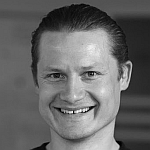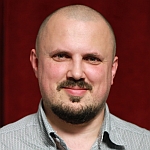Darius Šilingas 

Rokas Bartkevičius 

|
Dr. Darius Silingas has been involved in various roles in international software development projects since 1998. Currently, he leads Solutions Department at No Magic Europe, a vendor of famous modeling product MagicDraw™. Darius consults various famous companies worldwide on how to adopt MagicDraw™ for efficient modeling. Recently, he is often involved in consulting large organizations on adopting agile modeling practices in context of Scrum and other agile methods. Darius is a frequent speaker in premier international software conferences and an author of multiple papers focused on model based software engineering. He holds Ph.D. in Computer Science from Vytautas Magnus University and numerous professional certifications. Darius actively contributes to educating Lithuanian software professionals by organizing local conferences and seminars on modern software engineering practices, including a seminar on Agile development practices back in 2005. Rokas Bartkevicius is a Solution Architect at No Magic Europe, which develops popular UML modeling product MagicDraw. Rokas is responsible for consulting various MagicDraw customers on how to get most value from modeling and adopting modeling practices to fit diverse customer contexts. Before joining No Magic, Rokas worked as a developer, analyst, and project manager in Agile culture based software development company working in GIS domain, where he actively contributed to process improvement activities and acted as a modeling evangelist. Rokas holds Master in Computer Science and is OMG Certified UML Professional. Agile Modeling: from Anti-Patterns to Best PracticesIt is a popular myth that in agile development UML-based modeling is a redundant tool/practice that needs to be discarded. In fact, in large agile projects, modeling can be an essential tool for improving communication and preserving high-level knowledge such as domain concepts, user roles and use cases, system composition/integration architecture, etc. However, modeling is still immature practice, which causes many novice modelers to create models that directly replicate code details. Such models are of little value for improving communication and knowledge capturing. Also, they require huge maintenance effort and quickly get out of sync with code, which causes agile practitioners to take the modeling out of their toolbox. Scott Ambler, a famous agile evangelist, promotes agile modeling based on the best practices that help getting more value from simpler models. Although some of these best practices seem to be common sense, in real life we see a lot of anti-patterns that violate them in extremely severe ways. Best practices are not convincing if you are not aware what happens if you don’t follow them. People learn best from mistakes. Therefore, in this session we will discuss best practices for agile modeling starting from anti-patterns that are collected from 7 year modeling consultancy done in close to 100 organizations from 20 countries. For each anti-pattern, we will present UML diagram reflecting fragments from real-life modeling projects and discuss what problems modelers faced creating, using and maintaining it. Then we will introduce a corresponding best practice, which enables transforming information contained in presented anti-pattern into a valuable model element. After examining concrete cases, we will generalize a list of main principles of agile modeling and discuss how to build agile modeling culture in a software organization. |
Sergejus Barinovas 



http://sergejus.blogas.lt |
Sergejus is an Architect at Adform, focusing on Scalable Architecture, High-Performance Computing and Cloud Services. He is often speaker at various IT conferences, active community member, blogger (http://sergejus.blogas.lt), Lithuanian .NET User Group lead and Microsoft Most Valuable Professional (MVP). Sergejus is a strong believer in agile architecture and agile++ practices. Real-life experience: How to constantly innovate, evolve existing high-load system and not to fu** upYou have existing software with lots of customers but it's scary to roll-out new features? Please come and join this talk to know how we at Adform constantly innovate while evolving our high-load system (500M requests / day) by adapting various time-proven technics. Release Often Release Safely
View more presentations from Sergejus |
Audrys Kažukauskas 
|
Audrys Kazukauskas pioneered Extreme Programming at Net Frequency in 2006 and since then has been actively practicing XP as a developer and team lead in large scale software projects. Audrys is currently leading a constantly expanding team, which develops large travel meta-search engines. Big Design Up Front is Dead. Long Live Emergent Design.It is still common to blame insufficient requirement gathering or the lack of design at the early stage of a software project for all the unexpected changes you have to do down the road. While many are putting lots of energy into predicting the future and are consistently failing in doing it, agile teams don't waste time and simply get the job done. Do you feel your head explode each time you need to come up with the final design for a new big feature set? Have you experienced the moments of despair when you watch your design, once looking brilliant on paper, now falling apart after you've just started to implement it? Well, that happens when you try to make pigs fly. You'd better embrace Emergent Design. |
Saulius Grigaitis 

|
Saulius is the evangelist of Ruby and Extreme Programming. While being a student he didn’t find an attractive job, therefore he started a NECOLT company where he realized his dream – actually use Agile and innovative technologies on large scale projects. Saulius adopted Extreme Programming, Scrum and Kanban methods in his company. He also teaches “Agile Programming with Ruby” course at Vilnius University, organizes annual Lithuanian Ruby community conferences, actively participates in meetings and conferences of Agile and other open communities. Behavior Driven Development (BDD): By ExampleBehavior Driven Development (BDD) evolved from Test Driven Development (TDD), which is extensively used by Extreme Programming teams. This presentation will introduce you to BDD and it’s tools. I will do live web application BDD session with Ruby on Rails. |
Dmitry Lebedev 

|
Dmitry is a software development enthusiast, he has more than 14 years of experience in that field. He tried many roles: developer, test engineer, team lead, development manager, system analyst, software architect and agile coach. After getting familiar with XP methodology, he became big fan of Agile approach. And his passion for Agile is growing every year. Last year it helped Dmitry organize Agile Latvia community. Agile Testing Using Agile ToolsThis presentation explores what agile testing is, how test engineer can be involved in team activities, what are most valuable skills for agile tester. Practical side of presentation demonstrates how tester can perform his/her daily duties using modern programming language Ruby as a foundation for making testing easier and more fun, automating testing chores where it’s possible, creating some shortcuts in long and tedious processes. The presentation contains examples on testing automation, performance and load testing, gathering useful information from log files, working with database and some other things. Presentation will demonstrate how focus on a test automation could help to provide faster feedback and give more time for real exploring of app functionality, instead of boring manual data input and clicking through the application. All topics will contain Ruby code examples with explanations. Presentation is very practical, some basics of Agile testing will be given, and I will explain how these examples correlate with agile approach. |



 Sydney
Sydney Vienna
Vienna Aracaju
Aracaju Montreal
Montreal Santiago De Chile
Santiago De Chile Beijing
Beijing Kinshasa
Kinshasa Brescia
Brescia Bordeaux
Bordeaux Dublin
Dublin Bengaluru
Bengaluru Osaka
Osaka Vilnius
Vilnius Luxembourg
Luxembourg Ifrane
Ifrane Bucharest
Bucharest Genève
Genève Kiev
Kiev Philadelphia
Philadelphia Mérida
Mérida Ho Chi Minh City
Ho Chi Minh City


 I like AgileTour
I like AgileTour






